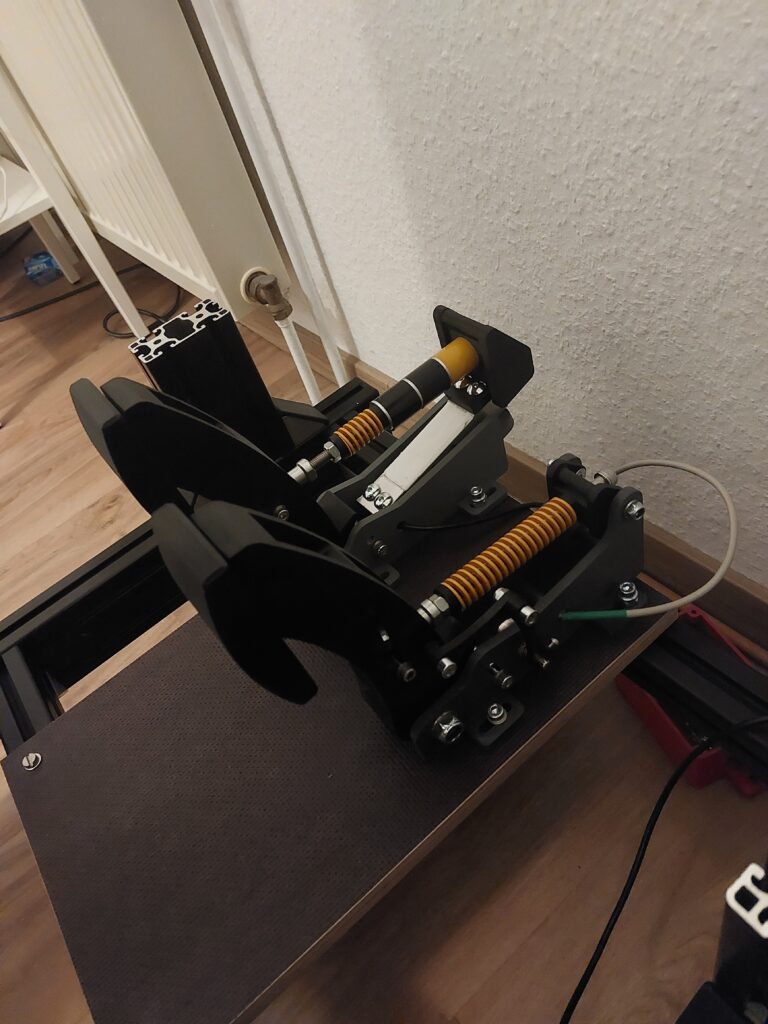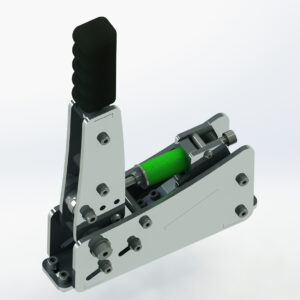I’m going to list you here 6 good reasons to make your own 3D Printed DIY Sim Racing Pedals. The advantages are the same as for the DIY Sim Racing Pedals.
DIY Sim Racing Pedals: the advantages
CUSTOMIZATION
3D printing allows for personalized designs tailored to individual preferences and ergonomics, ensuring optimal comfort and performance.
COST-EFFECTIVE
Producing pedals via 3D printing can be more affordable than purchasing pre-made ones, especially when considering the customization options.
LIGHTWEIGHT
The 3D printed sim pedals can be designed to be lightweight yet durable, improving the overall feel and response time.
ACCESSIBILITY
With the widespread availability of 3D printers and downloadable designs, anyone can create high-quality racing pedals at home.
MATERIAL VARIETY
Choose from a range of materials to balance strength, flexibility, and cost, tailoring the pedal to specific needs and preferences.
MAINTENANCE
Easy to replace or modify individual parts without needing to replace the entire pedal assembly, reducing long-term costs.
Strength and Durability of your 3D Printed Sim Pedals
MATERIAL SELECTION
The strength and durability of the pedals largely depend on the material used. High-quality filaments such as PLA offer excellent strength and resilience, making the pedals capable of withstanding significant pressure and stress. Here are recommendations for printing 3D solid parts.
DESIGN OPTIMIZATION
3D printing allows for intricate designs with optimized geometry. This means that the 3D printed sim pedals is designed with reinforced structures that provide additional strength without adding excessive weight. The longest part that need to be printed is 220mm.
CUSTOMIZATION AND MAINTENANCE
One advantage of 3D printing is the ease of maintenance and customization. If a part of the pedal wears out or breaks, it can be easily reprinted and replaced. This ensures the overall durability of the pedal system is maintained over time.
SHOPPING LIST FOR YOUR DIY SIM RACING PEDALS
SPRINGS AND ELASTOMERS
- Throttle Spring [Quantity 1] [Option: Length: 90mm, Diameter: 20mm]
- Throttle Spring alternative 1 [Quantity 1] [Option: length 90mm, Diameter 20mm]
- Throttle Spring alternative 2 [Quantity 1] [Option: Color: yellow, Specification: 18x9x100]
- Brake Spring [Quantity 1] [Option: Length 30mm, Diameter 20mm]
- Brake Spring alternative 1 [Quantity 1] [Option: Length 30mm, Diameter 20mm]
- Brake Spring alternative 2 [Quantity: 1] [Option: Color: yellow, Specification: 18x9x40]
- Clutch Spring [Quantity 1] [Option: Length: 90mm, Diameter: 20mm]
- Bushing/Elastomers [Quantity: 2 minimum] [Option: 85A or/and 90A]
- Alternative link for Elastomers #1
- Alternative link for Elastomers #2 [Quantity: 3 minimum] [Option: D25/8,5x25mm]
- Alternative link for Elastomers #3
- Alternative link for Elastomers #4
- Alternative link for Elastomers #5
- Solution-elastomeres [Options: Length 250mm, External diameter Ø32mm, Internal diameter Ø8,5mm, Shore/Hardness 80-90-99]
POTENTIOMETERS AND LOADCELL
- P260 potentiometer [Quantity: 2]
- Potentiometers alternative [Quantity: 2] [Option: 10k Ohm]
- Brake Loadcell [Quantity: 1] [Option: 120kg]
USB BOARDS (only one of them is mandatory)
- Leobodnar BU0836-LC 12-bit [Quantity: 1]
- Leobodnar LC-USB 16-bit [Quantity: 1]
- USB Type A to B for Leobodnar and DSD boards [Quantity: 1]
- DSD 12 Bit Controller [Quantity: 1] [Option: 12 Bit Controller with AMP]
- DiyMore Arduino Leonardo board [Quantity: 1] Note: only with HX711 Loadcell Amplifier
- Micro USB cable for DiyMore Arduino Leonardo board [Quantity: 1] [Option: 3m]
- Arduino Pro Micro [Quantity: 1] [Option: Mini USB 3-6V] Note: only with HX711 Loadcell Amplifier
- Mini USB cable for Arduino Pro Micro board
- HX711 Amplifier (Option: Standard Board)
- Alternative Sparkfun HX711 Loadcell Amplifier [Quantity: 1]
REVIEWS OF THE DIY SIM PEDALS
“In regards to the 3D printed version I will say I try to beat these up so hard, I smashed on them, I really figured they would break they just didn’t in my testing.” – Shaun Cole (The SimPit)
BUILDING OF THE DIY SIM RACING PEDALS
A second tutorial is available here.






















Very good and budget friendly project. Any question was quickly answered by author. I can recommend it to everyone
Great work 🙂 the 3d printed pedals are a solid choice! The build is a two pedal version, without a clutch. My T3pa pedals are like a toy in comparision. The whole project was a great experience and the support from Diysimstudios was more than awesome :)) any question was answered very quickly via Email. Highly recommend to do that diy project. Best regards and have fun 😉 Jonas